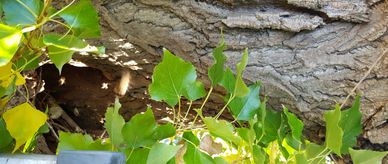0421 885 338
Poplar Runaway
A Tall Home

The bees set up in this old Poplar Tree. Tree relocations are the hardest type of relocation because the queen has many more places to hide, often they take anything from 2 - 5 days and they can be very unsafe if not completed correctly.
An Inconvenient Location

The hive started three meters from the ground in the main trunk of this tree. This gave us only two options. We could do a trap-out which involves allowing the bees to leave the hive but not let them return. This comes with many complications and issues. Or we could cut the top off the tree and then safely access the hive.
Zooming In On The Entrance

The hive entrance was found in the fork of the main trunk well sheltered by the surrounding leaf cover.
Looking Up At The Hive

Looking up into the hive and seeing the bees hard at work is an amazing site.
Removing The Top
Removing The Top

Given how oddly shaped this Poplar was our normal scaffolding would not have worked in gaining us access to where we needed to be. This meant we had to build a safety platform and rails in the tree in order to take the top off the tree.
Trimmed Tree
Removing The Top

The owners were not worried about taking the top off the tree so we safely removed the top above the level of the hive. By doing this we did not need to attempt to trap the bees out.
Safe Work Space
Gauging The Depth
Gauging The Depth

With the tree trunk reduced to a safe working height we then re-made the safety platform into a safe relocation work space. Safety must always come first as one slip from three meters up can result in disaster.
Gauging The Depth
Gauging The Depth
Gauging The Depth

Obviously we can not see the exact depth of the hive when it's encased in the tree. Thus starts the painstakingly slow process of gauging the depth with a drill then carefully peeling back layers of the tree until we can access the hive.
A Glorious Site
Gauging The Depth
A Glorious Site

There is no better feeling than unwrapping such a complex hive and seeing the bees happily working away unharmed.
Exposed Hive
Removing The Comb
A Glorious Site

Now that the hive is fully exposed we are able to really get started. It only took three days to get to this point.
Removing The Comb
Removing The Comb
Removing The Comb

Gently the comb is removed from the hive and tied into frames and then placed in the new hive box.
The Queen Part 1
Removing The Comb
Removing The Comb

The bees kindly showed me where their queen was hiding. Given she has so many places to hide you'd think I would quickly grab her and put her in the hive, thus making the relocation almost complete. Unfortunately the lure of getting a photo of the queen was too strong. See if you can find her in this photo as it was the last time I saw her for 24 hours. After taking the photo the queen moved down into the tree cavity where I couldn't reach her.... Adding another full day of work to this relocation!
All Framed Up
Cleaning the Work Space

Knowing we couldn't catch the queen where she was hiding we finished boxing up the hive. This meant we would be ready when we worked out how to capture the queen who was now out of reach.
Cleaning the Work Space
Cleaning the Work Space

It makes life so much easier when the hive cleans up the honey on the work bench. The waste comb in the image did not have honey or brood in it as such there was no reason to put it in the new hive. It gets stored for later rendering.
Propolis

A great example of bees coating everything in propolis. Propolis is made from mixing wood fibers and honey. The bees use it to fill up gaps and stabilise/strengthen things within the hive.
Hive Water Feature
Hive Water Feature

Now it was time to catch the queen. If we were to cut a hole lower down the trunk there was always a risk of killing her accidentally. This meant our best option was to slowly fill the rest of the hollow in the trunk with water which would push the queen up to a level where we could easily capture her. Five Hours Later!...
The Queen Part 2
Hive Water Feature
The Queen Part 2

After five hours the queen decided it was time to move. She ran to a nearby tree and took a few of her workers with her. From there it was a simple matter of catching her and putting her in the hive box.
Five Days Of Fun
Hive Water Feature
The Queen Part 2

Five days after starting the relocation it was finally complete. As always the hive box was left onsite for several days while the bees reorganised the hive and any stragglers found the hive. On collection night the old hive was bare of bees and the colony was enjoying their new home.
Copyright © 2025 Bee Removals Victoria - All Rights Reserved.